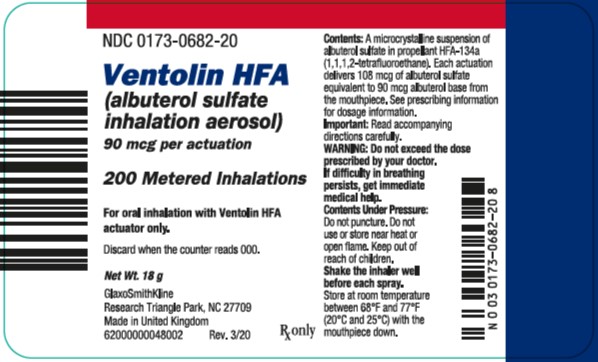Ventolin HFA
Generic name: albuterol inhalation
Drug class: Adrenergic bronchodilators
Medically reviewed by A Ras MD.
What is Ventolin HFA?
Ventolin HFA is a prescription inhaled medicine used in people aged 4 years and older to treat or prevent bronchospasm in people who have reversible obstructive airway disease, prevent exercise-induced bronchospasm
It is not known if Ventolin HFA is safe and effective in children younger than 4 years of age.
Description
The active component of VENTOLIN HFA is albuterol sulfate, USP, the racemic form of albuterol and a relatively selective beta2-adrenergic bronchodilator. Albuterol sulfate has the chemical name α1-[(tert-butylamino)methyl]-4-hydroxy-m-xylene-α, α′-diol sulfate (2:1)(salt) and the following chemical structure:

Albuterol sulfate is a white crystalline powder with a molecular weight of 576.7, and the empirical formula is (C13H21NO3)2•H2SO4. It is soluble in water and slightly soluble in ethanol.
The World Health Organization recommended name for albuterol base is salbutamol.
VENTOLIN HFA is a blue plastic inhaler with a blue cap containing a pressurized metered-dose aerosol canister fitted with a counter. Each canister contains a microcrystalline suspension of albuterol sulfate in propellant HFA-134a (1,1,1,2-tetrafluoroethane). It contains no other excipients.
After priming, each actuation of the inhaler delivers 120 mcg of albuterol sulfate, USP in 75 mg of suspension from the valve and 108 mcg of albuterol sulfate, USP from the mouthpiece (equivalent to 90 mcg of albuterol base from the mouthpiece).
Prime VENTOLIN HFA before using for the first time, when the inhaler has not been used for more than 2 weeks, or when the inhaler has been dropped. To prime VENTOLIN HFA, release 4 sprays into the air away from the face, shaking well before each spray. Avoid spraying in eyes.
Mechanism of Action
In vitro studies and in vivo pharmacologic studies have demonstrated that albuterol has a preferential effect on beta2-adrenergic receptors compared with isoproterenol. Although beta2-adrenoceptors are the predominant adrenergic receptors in bronchial smooth muscle and beta1-adrenoceptors are the predominant receptors in the heart, there are also beta2-adrenoceptors in the human heart comprising 10% to 50% of the total beta-adrenoceptors. The precise function of these receptors has not been established, but their presence raises the possibility that even selective beta2-agonists may have cardiac effects.
Activation of beta2-adrenergic receptors on airway smooth muscle leads to the activation of adenyl cyclase and to an increase in the intracellular concentration of cyclic-3′,5′-adenosine monophosphate (cyclic AMP). This increase of cyclic AMP leads to the activation of protein kinase A, which inhibits the phosphorylation of myosin and lowers intracellular ionic calcium concentrations, resulting in relaxation. Albuterol relaxes the smooth muscles of all airways, from the trachea to the terminal bronchioles. Albuterol acts as a functional antagonist to relax the airway irrespective of the spasmogen involved, thus protecting against all bronchoconstrictor challenges. Increased cyclic AMP concentrations are also associated with the inhibition of release of mediators from mast cells in the airway.
Albuterol has been shown in most controlled clinical trials to have more effect on the respiratory tract, in the form of bronchial smooth muscle relaxation, than isoproterenol at comparable doses while producing fewer cardiovascular effects. Controlled clinical studies and other clinical experience have shown that inhaled albuterol, like other beta-adrenergic agonist drugs, can produce a significant cardiovascular effect in some patients, as measured by pulse rate, blood pressure, symptoms, and/or electrocardiographic changes
Who should not use Ventolin HFA?
Do not use Ventolin HFA:
- if you are allergic to albuterol sulfate or any of the ingredients in Ventolin HFA. See the end of this Patient Information for a complete list of ingredients in Ventolin HFA.
What should I tell my healthcare provider before using Ventolin HFA?
Before using Ventolin HFA, tell your healthcare provider about all of your medical conditions, including if you:
- have heart problems.
- have high blood pressure.
- have seizures.
- have thyroid problems.
- have diabetes.
- have low potassium levels in your blood.
- are pregnant or planning to become pregnant. It is not known if Ventolin HFA may harm your unborn baby.
- Pregnancy Registry. There is a pregnancy registry for women with asthma who receive asthma medications, including Ventolin HFA, while pregnant. The purpose of the registry is to collect information about the health of you and your baby. You can talk to your healthcare provider about how to take part in this registry or you can get more information and register by calling 1-877-311-8972 or go to https://mothertobaby.org/ongoing-study/asthma.
- are breastfeeding. It is not known if the medicine in Ventolin HFA passes into your milk and if it can harm your baby.
Tell your healthcare provider about all the medicines you take, including prescription and over-the-counter medicines, vitamins, and herbal supplements. Ventolin HFA and certain other medicines may interact with each other. This may cause serious side effects. Especially tell your healthcare provider if you take:
- other inhaled medicines or asthma medicines
- beta-blocker medicines
- diuretics
- digoxin
- monoamine oxidase inhibitors
- tricyclic antidepressants
Know the medicines you take. Keep a list of them to show your healthcare provider and pharmacist when you get a new medicine.
How should I use Ventolin HFA?
Read the step-by-step instructions for using Ventolin HFA that came with you medication.
- Do not use Ventolin HFA unless your healthcare provider has taught you how to use the inhaler and you understand how to use it correctly.
- Children should use Ventolin HFA with an adult’s help, as instructed by the child’s healthcare provider.
- Use Ventolin HFA exactly as your healthcare provider tells you to use it. Do not use Ventolin HFA more often than prescribed.
- Do not increase your dose or take extra doses of Ventolin HFA without first talking to your healthcare provider.
- Each dose of Ventolin HFA should last up to 4 hours to 6 hours.
- Get medical help right away if Ventolin HFA no longer helps your symptoms.
- Get medical help right away if your symptoms get worse or if you need to use your inhaler more often.
- While you are using Ventolin HFA, use other inhaled medicines and asthma medicines only as directed by your healthcare provider.
- Call your healthcare provider if your asthma symptoms like wheezing and trouble breathing become worse over a few hours or days. Your healthcare provider may need to give you another medicine to treat your symptoms.
What are the possible side effects with Ventolin HFA?
Ventolin HFA can cause serious side effects, including:
- worsening trouble breathing, coughing, and wheezing (paradoxical bronchospasm). If this happens, stop using Ventolin HFA and call your healthcare provider or get emergency help right away. Paradoxical bronchospasm is more likely to happen with your first use of a new canister of medicine.
- heart problems, including faster heart rate and higher blood pressure
- possible death in people with asthma who use too much Ventolin HFA
- serious allergic reactions. Call your healthcare provider or get emergency medical care if you get any of the following symptoms of a serious allergic reaction:
- rash
- hives
- swelling of your face, mouth, and tongue
- breathing problems
- changes in laboratory blood levels (sugar, potassium)
Common side effects of Ventolin HFA include:
- sore throat
- upper respiratory tract infection, including viral infection
- cough
- muscle pain
- your heart feels like it is pounding or racing (palpitations)
- chest pain
- fast heart rate
- shakiness
- nervousness
- dizziness
Tell your healthcare provider about any side effect that bothers you or that does not go away.
These are not all the side effects with Ventolin HFA. Ask your healthcare provider or pharmacist for more information.
Call your doctor for medical advice about side effects. You may report side effects to FDA at 1-800-FDA-1088.
General information about the safe and effective use of Ventolin HFA
Medicines are sometimes prescribed for purposes not mentioned in a Patient Information leaflet. Do not use Ventolin HFA for a condition for which it was not prescribed. Do not give your Ventolin HFA to other people, even if they have the same condition that you have. It may harm them.
You can ask your healthcare provider or pharmacist for information about Ventolin HFA that was written for healthcare professionals.
How should I store Ventolin HFA?
- Store Ventolin HFA at room temperature between 68°F and 77°F (20°C and 25°C) with the mouthpiece down.
- The contents of your Ventolin HFA are under pressure: Do not puncture. Do not use or store near heat or open flame. Temperatures above 120°F may cause the canister to burst.
- Do not throw into fire or an incinerator.
Keep Ventolin HFA and all medicines out of the reach of children.
What are the ingredients in Ventolin HFA?
Active ingredient: albuterol sulfate
Inactive ingredient: propellant HFA-134a
For more information about Ventolin HFA, call 1-888-825-5249.
Instructions for use for Ventolin HFA
Ventolin (VENT o lin) HFA
(albuterol sulfate inhalation aerosol)
For oral inhalation use
Your Ventolin HFA inhaler
- The metal canister holds the medicine. See Figure A.
- The metal canister has a counter to show how many sprays of medicine you have left. The number shows through a window in the back of the plastic actuator. See Figure A.
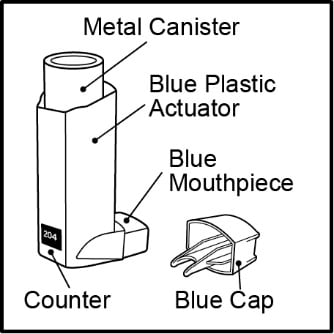
Figure A
- The counter starts at either 204 or 064, depending on which size inhaler you have. The number will count down by 1 each time you spray the inhaler. The counter will stop counting at 000.
- Do not try to change the numbers or take the counter off the metal canister. The counter cannot be reset, and it is permanently attached to the metal canister.
- The blue plastic actuator sprays the medicine from the metal canister. The plastic actuator has a blue protective cap that covers the mouthpiece. See Figure A. Keep the protective cap on the mouthpiece when the metal canister is not in use.
- Do not use the plastic actuator with a canister of medicine from any other inhaler.
- Do not use a Ventolin HFA metal canister with an actuator from any other inhaler.
Before using your Ventolin HFA inhaler
- The inhaler should be at room temperature before you use it.
- If your child needs to use Ventolin HFA, watch your child closely to make sure your child uses the inhaler correctly. Your healthcare provider will show you how your child should use Ventolin HFA.
Priming your Ventolin HFA inhaler
Before you use Ventolin HFA for the first time, you must prime the inhaler so that you will get the right amount of medicine when you use it.
- To take the cap off the mouthpiece, squeeze the sides of the cap and pull out. See Figure B.
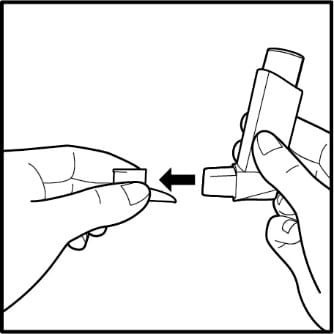
Figure B - Shake the inhaler well.
- Spray the inhaler 1 time into the air away from your face. Avoid spraying in eyes. See Figure C.
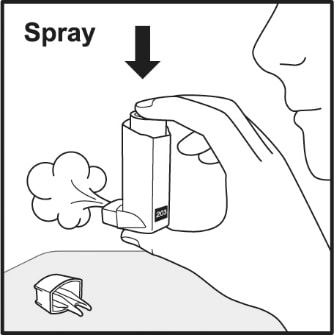
Figure C - Shake and spray the inhaler like this 3 more times to finish priming it. The counter should now read 200 or 060, depending on which size inhaler you have. See Figure D.
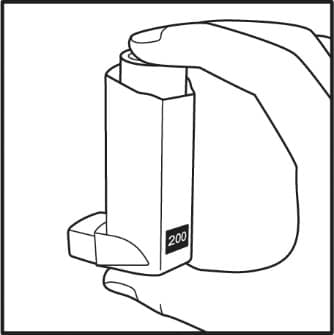
Figure D - You must prime your inhaler again if you have not used it in more than 14 days or if you have dropped it. Take the cap off the mouthpiece and shake and spray the inhaler 4 times into the air away from your face.
How to use your Ventolin HFA inhaler
Follow these steps every time you use Ventolin HFA.
Step 1. Make sure the metal canister fits firmly in the plastic actuator. The counter should show through the window in the plastic actuator.
To take the cap off the mouthpiece, squeeze the sides of the cap and pull out. Look inside the mouthpiece for foreign objects and take out any you see.
Step 2. Hold the inhaler with the mouthpiece down and shake it well. See Figure E.
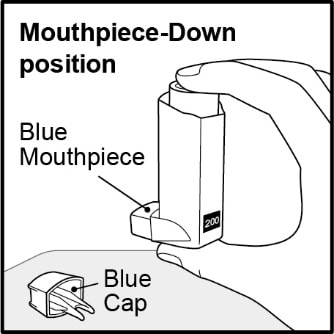
Figure E
Step 3. Breathe out through your mouth and push as much air from your lungs as you can. See Figure F.
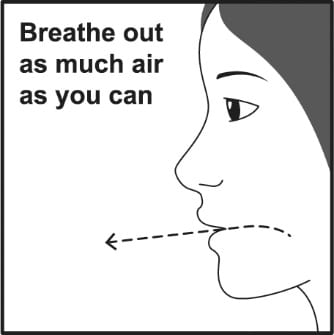
Figure F
Step 4. Put the mouthpiece in your mouth and close your lips around it. Push the top of the metal canister firmly all the way down while you breathe in deeply and slowly through your mouth. See Figure G.
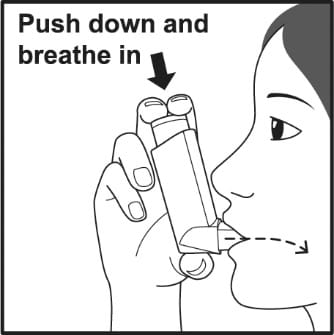
Figure G
Step 5. After the spray comes out, take your finger off the metal canister. After you have breathed in all the way, take the inhaler out of your mouth and close your mouth.
Step 6. Hold your breath for about 10 seconds, or for as long as is comfortable. Breathe out slowly as long as you can.
If your healthcare provider has told you to use more sprays, wait 1 minute and shake the inhaler again. Repeat Steps 2 through Step 6.
Put the cap back on the mouthpiece after you finish using the inhaler. Make sure it snaps firmly into place.
Cleaning your Ventolin HFA inhaler
Clean your inhaler at least 1 time each week. You may not see any medicine build-up on the inhaler, but it is important to keep it clean so medicine build-up will not block the spray. See Figure H.
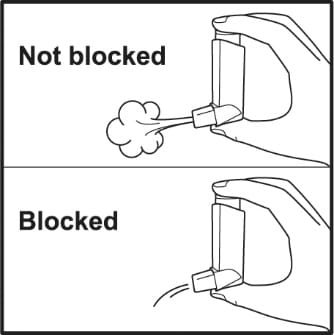
Figure H
Step 7. Take the canister out of the plastic actuator and take the cap off the mouthpiece by squeezing the sides of the cap and pulling it straight out.
Step 8. Hold the actuator under the faucet and run warm water through it for about 30 seconds. See Figure I.
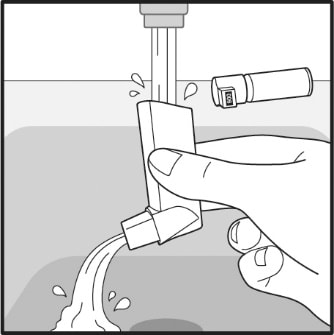
Figure I
Step 9. Turn the actuator upside down and run warm water through the mouthpiece for about 30 seconds. See Figure J.
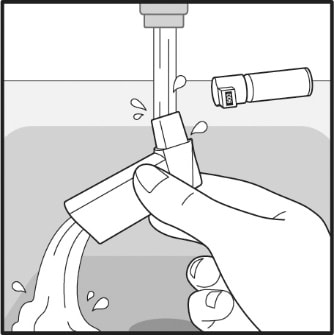
Figure J
Step 10. Shake off as much water from the plastic actuator as you can. Look into the mouthpiece to make sure any medicine build-up has been completely washed away. If there is any build-up, repeat Steps 8 and 9.
Step 11. Let the actuator air-dry overnight. See Figure K.
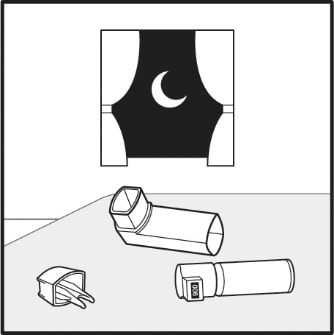
Figure K
Step 12. When the plastic actuator is dry, put the protective cap on the mouthpiece and then put the canister in the plastic actuator and make sure it fits firmly. Shake the inhaler well, remove the cap, and spray the inhaler 1 time into the air away from your face. (The counter will count down by 1 number.) Put the cap back on the mouthpiece.
If you need to use your inhaler before the plastic actuator is completely dry:
- Shake as much water off the plastic actuator as you can.
- Put the cap on the mouthpiece and then put the canister in the plastic actuator and make sure it fits firmly.
- Shake the inhaler well, remove the cap, and spray it 1 time into the air away from your face.
- Take your Ventolin HFA dose as prescribed.
- Follow cleaning Steps 7 through 12 above.
Replacing your Ventolin HFA inhaler
- When the counter reads 020, you should refill your prescription or ask your healthcare provider if you need another prescription for Ventolin HFA.
- When the counter reads 000, throw the inhaler away. You should not keep using the inhaler when the counter reads 000 because you will not receive the right amount of medicine.
- Do not use the inhaler after the expiration date, which is on the packaging it comes in.
For correct use of your Ventolin HFA inhaler, remember:
- The metal canister should always fit firmly in the plastic actuator.
- Breathe in deeply and slowly to make sure you get all the medicine.
- Hold your breath for about 10 seconds after breathing in the medicine. Then breathe out fully.
- Always keep the protective cap on the mouthpiece when your inhaler is not in use.
- Always store your inhaler with the mouthpiece pointing down.
- Clean your inhaler at least 1 time each week.
Label
PRINCIPAL DISPLAY PANEL
- NDC 0173-0682-20
- Ventolin HFA
- (albuterol sulfate inhalation aerosol)
- 90 mcg per actuation
- 200 Metered Inhalations
- For oral inhalation with Ventolin HFA actuator only.
- Discard when the counter reads 000.
- Net Wt. 18 g
- GlaxoSmithKline
- Research Triangle Park, NC 27709
- Made in United Kingdom
- Rx only
- Contents: A microcrystalline suspension of albuterol sulfate in propellant HFA-134a (1,1,1,2-tetrafluoroethane). Each actuation delivers 108 mcg of albuterol sulfate equivalent to 90 mcg albuterol base from the mouthpiece. See prescribing information for dosage information.
- Important: Read accompanying directions carefully.
- WARNING: Do not exceed the dose prescribed by your doctor.
- If difficulty in breathing persists, get immediate medical help.
- Contents Under Pressure: Do not puncture. Do not use or store near heat or open flame. Keep out of reach of children.
- Shake the inhaler well before each spray.
- Store at room temperature between 68oF and 77oF (20oC and 25oC). with the mouthpiece down.
- 62000000048002 Rev. 3/20
-
